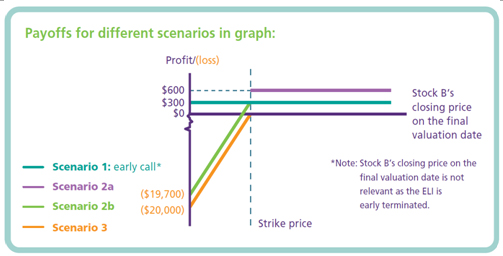Early call
An early call feature allows the issuer to terminate your investment before maturity if certain conditions are met.
A bull ELI with an early call feature will be terminated before its maturity date if the closing price of the reference asset on a call date is at or above the pre-determined call price.
In case of an early call, you will receive on the early settlement date the nominal amount, plus (in case the daily accrual feature is applicable) any potential distribution amount accrued up to the relevant call date. In other words, the potential gain of an ELI with early call feature depends on whether it is terminated before maturity. If the ELI is not called early, the potential gain or loss of the ELI will then depend on whether the final price is at or above the strike price.
The issuer may set multiple call dates, which can be in the form of every exchange business day (daily call feature) or certain periodic dates (e.g. monthly, quarterly) within the investment period (periodic call feature). Different call prices can also be set for different call dates.
If an ELI is terminated before its maturity date, you will bear the re-investment risk. That is, if an early call occurs, you will not receive any further potential distribution amount. You may not be able to get the same rate of return if you re-invest in another ELI with similar risk parameters.
Before we explain the details of the early call feature, let us introduce the following common terms:
Call date is a date to evaluate if early call conditions are met.
Call price of the reference stock is predefined by the issuer and is set at a specified percentage of its initial spot price.
Early settlement date is usually set at a number of business days following the call date.
| Example: Bull ELI on Stock B with early call and fixed coupon accrual feature | |
| Nominal amount | $20,000 |
|---|---|
| Purchase price | $20,000 |
| Issue date | 23 January |
| Initial spot price of Stock B | $50 |
| Strike price | 80% of initial spot price (i.e. $40) |
| Call price | 96% of initial spot price (i.e. $48) |
| Quarterly coupon rate | 1.5% |
| Coupon accrual price | 92% of initial spot price (i.e. $46) |
| Distribution observation date | 23 April, 22 July |
| Call date | 23 April |
| Early settlement date | 25 April |
| Scheduled final valuation date | 22 July |
| Scheduled maturity date | 24 July |
| Scheduled Investment period | 6 months |
In this example, there is also a fixed coupon accrual feature. If the closing price of Stock B on the distribution observation date for the period is at or above the applicable coupon accrual price, you will receive a fixed coupon amount at the quarterly coupon rate for such period.
Your total gain/loss will be determined by the closing price of Stock B on:
- The first distribution observation date
- The call date
- The second distribution observation date (if early call condition is not met); and
- The final valuation date (if early call condition is not met)
In this example, the periodic potential distribution amount, if any, will be determined by the closing price of Stock B on the corresponding distribution observation date.
 |
 |
Based on the assumed price movement of Stock B under different scenarios as shown in the above diagram, you can expect the following results:
Scenario 1:
You will receive the nominal amount and the first potential distribution amount. An investment gain of: $20,000 + $300 - $20,000 = $300
Scenario 2a (best case):
You will receive the nominal amount and the first and second potential distribution amounts. An investment gain of:$20,000 +$300 + $300 - $20,000 = $600
Scenario 2b (loss case):
You will receive 500 shares of Stock B and the first potential distribution amount. A paper loss of: $17,500 + $300 - $20,000 = ($2,200)
Scenario 3 (loss case):
You will receive 500 shares of Stock B and no potential distribution amount. A paper loss of: $17,500 - $20,000 = ($2,500)
 |
Please note that the examples and figures used in this section are purely hypothetical and are for illustrative purposes only.



